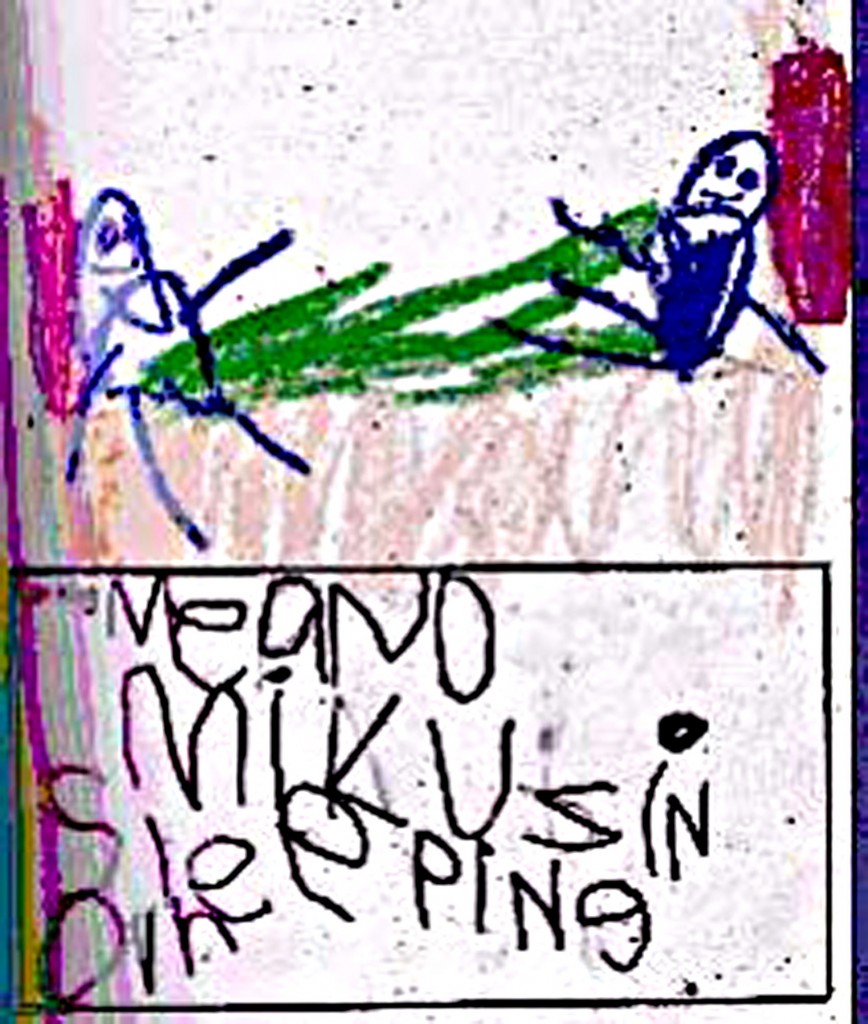FEEDBACK IN PRACTICE
Look at the following case study.
Provide descriptive, not evaluative, feedback about the sample.
[button link=”https://moedu-sail.org/lessons/feedback-in-action/#secondary” color=”custom” size=”large” stretch=”” type=”flat” shape=”round” target=”_self” title=”” gradient_colors=”transparent” gradient_hover_colors=”rgba(000,000,000,.03)” accent_color=”” accent_hover_color=”” bevel_color=”” border_width=”1px” shadow=”no” icon=”” icon_divider=”yes” icon_position=”left” modal=”” animation_type=”0″ animation_direction=”up” animation_speed=”1″ animation_offset=”” alignment=”left” class=”” id=””]Click for a case study with older students[/button]
[separator style_type=”none” top_margin=”10″ bottom_margin=”10″ sep_color=”” border_size=”” icon=”” icon_circle=”” icon_circle_color=”” width=”” alignment=”center” class=”” id=””]
[one_half]
[/one_half][one_half last=”yes”]
The key that I want to remember is that feedback should be in response to students’ thinking or actions, and occur to deepen or help students’ understandings be accurate. So in the case of the kindergarten student I am going to assume the goal is to write a sentence to describe what is happening in the picture, and that a kindergartener who can write words that are spelled correctly probably understands to follow conventions of writing as well, such as including spacing between words. After the student reads their sentence to me, I might say, “You read the words you wrote here. I noticed that you knew to write smiley e’s for the long e sound in sleeping, and you also remembered that /ing/ at the end of words is spelled with i-n-g. Now I am wondering if you remember what helps readers and writers keep track of the words in sentences so the words won’t become a string of letters…What can you do as a writer to make your words distinct?”
What if the student who wrote this was in 4th grade? Can you still provide positive descriptive feedback? What would you say to the older student?
If this were a 2nd grade student, I can still provide descriptive feedback by reinforcing the similar rules of spelling applied, such as –ing ending and long e sound in the middle of sleeping. Again depending on the learning target I might ask different questions. If the learning target is about long vowel sounds, I might say, “I see you knew to write two ee’s for the long vowel sound in ‘sleeping’. What other ways is the long vowel sound represented in words. Can you think of an example of another word where e says its name? “ If the learning target is to provide a drawing representation of a sentence I might say, “Let’s take a look at the rubric about drawing representations and see how your drawing for the sentence you wrote compares to the goal for this activity”. Finally, if the learning target was about using emergent writing skills (i.e., invented spelling, knows sight words, etc.),“I noticed you knew the conventional spelling of the sight words “me” and “and”. What do you notice about “mi” as you have written it?
[/one_half]
Look at the following case study.
Provide descriptive, not evaluative, feedback about the sample.
[one_half]
[/one_half][one_half last=”yes”]
In order to provide clear, specific feedback to the 4th grade student, I would want to make sure that the narrative writing assignment had a rubric that was introduced to the students as they began the writing process. I would work to keep feedback focused on the goals of the assignment. I am reminded that good feedback occurs when just the right amount of feedback is given. If I point out too many things that need changed or improved, then the feedback will not be helpful to the student. I would tell the student, “You started your story with a clear introduction that got me thinking about the topic you were writing about. You also provided details about your own experiences. I am wondering as we read this together, if you noticed anything about the organization of the sentences?” I would then have a dialogue to scaffold the student to understanding clear paragraphs within a narrative.
What if the student who wrote this was in 11th grade? Can you still provide positive descriptive feedback? What would you say to the older student?
If this were an 11th grade student, I would still provide positive, descriptive feedback. I would start where the student was in accordance with the learning target and ask questions/make suggestions to help the student improve their writing piece, such as paragraph formation and selecting more complex vocabulary.
Questions concerning teacher feedback to students.
The following word document can be used to observe other teachers and it can also be used as a guide as you consider your own classroom practice regarding feedback. For example, consider the following scenario. A student is failing science and has been described by the science teacher as “unmotivated.” The student does well in all of his other classes. During fidelity checks by the supervisor and fellow teachers, it has become apparent there are concerns regarding the feedback that is provided to the student in the science classroom. You can use the Word document below, Questions for Data Teams Concerning Teacher Feedback to Students, to think about the kinds of feedback that might help motivate the student in science.
- If you were the science teacher, which questions do you think might be the most important to consider? Why do you think that?
- How might a supervisor or colleague use the Questions for Data Teams to coach the science teacher towards more effective feedback?
- Are there additional elements that might need to be considered?
![]() Questions Concerning Teacher Feedback to Students
Questions Concerning Teacher Feedback to Students
[modal name=”componentrubric” title=”Example Response” size=”large” background=”” border_color=”” show_footer=”no” class=”” id=””]I am keeping in mind that feedback is critical for guiding students from where they are to the learning target. If a student is unmotivated in my classroom, I may not be providing clear, tangible feedback that is goal-referenced—three keys of giving effective feedback. I should also consider the questions that address helping students to learn the science material in a timely manner, such as:
- Am I providing clear explanations of inaccuracies?
- Am I providing an opportunity immediately to correct errors?
These considerations reflect the keys of timely manner and actionable feedback. Finally, I need to consider my communication approaches as another key to implementing feedback:
- Does the environment and my communication support feedback in a user-friendly way?[/modal][fullwidth background_color=”” background_image=”” background_parallax=”none” parallax_speed=”0.1″ enable_mobile=”no” background_repeat=”no-repeat” background_position=”left top” video_url=”” video_aspect_ratio=”16:9″ video_webm=”” video_mp4=”” video_ogv=”” video_preview_image=”” overlay_color=”” overlay_opacity=”0.5″ video_mute=”yes” video_loop=”yes” fade=”no” border_size=”0px” border_color=”” border_style=”solid” padding_top=”20″ padding_bottom=”20″ padding_left=”” padding_right=”” hundred_percent=”no” equal_height_columns=”no” menu_anchor=”” class=”” id=””][button link=”” color=”custom” size=”large” stretch=”no” type=”flat” shape=”round” target=”” title=”” gradient_colors=”transparent” gradient_hover_colors=”rgba(000,000,000,.03)” accent_color=”rgb(18, 67, 111)” accent_hover_color=”rgb(18,67,111)” bevel_color=”” border_width=”1px” shadow=”no” icon=”” icon_divider=”yes” icon_position=”left” modal=”componentrubric” animation_type=”0″ animation_direction=”up” animation_speed=”1″ animation_offset=”” alignment=”left” class=”” id=””]Click here to see an example response[/button][/fullwidth]
Watch the following videos.
The following videos provide a variety of ways that specific feedback enhances teaching and learning experiences.
Go here to watch: https://www.teachingchannel.org/videos/positive-feedback-to-students
Go here to watch: https://www.teachingchannel.org/videos/personalize-feedback-for-students
Go here to watch: https://www.teachingchannel.org/videos/student-feedback-through-technology


